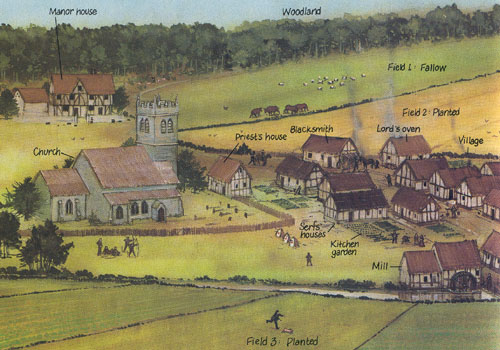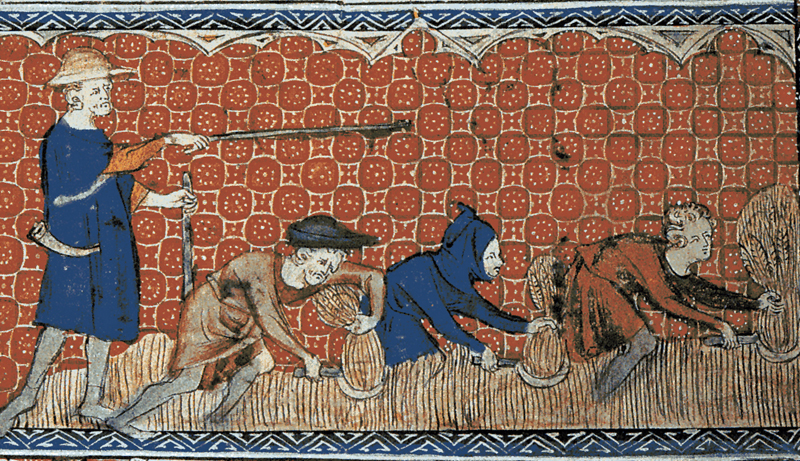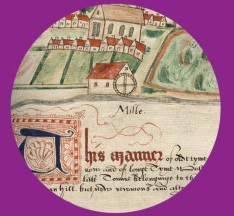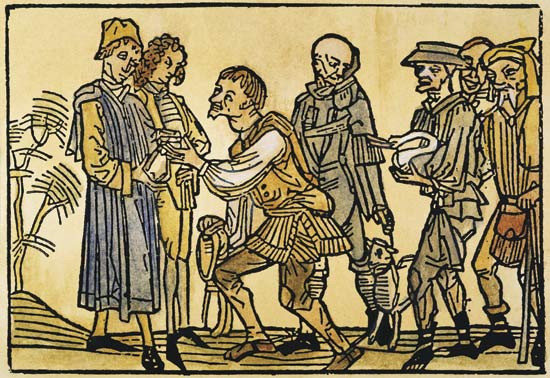Through our manorial research we often come across references to serfdom, the ancient custom where people were owned by the lord of the manor. Though a complicated picture unfree people at this time largely fell into two types – villeins or bondsmen, who were unfree tenants that had some rights of inheritance over their home and land, and serfs, who were personally unfree. Some had far fewer rights and freedoms than others, and these are often hard to define as manorial structure differed from manor to manor.
After the Black Death the remaining workforce was in demand, and both groups were able to acquire better rights. This meant that in most places these sorts of ties to the land and the lord died out. However serfs could still be found in the 14th and 15th century in Woodhorn, Seaton, Hurst, Newbiggin and the barony of Mitford. These people formed the backbone of the manorial system, but leave very little trace in the historical record. However in the course of our research for our Manor Authority files (see this previous blog for how this is done) we sometimes find their names given, a fantastic insight into ordinary people’s lives in the medieval period. We will be looking at examples we have come across that help explain the lives of unfree serfs and bondsmen in Northumberland’s manors, and show what services to the lord of the manor were expected of them.

Some serfs were made and some were born. Roger Maudut claimed Ralph le Lorimer as his ‘nief’. This is a term for a type of serf, from old French, and is often found as native or nativi, a serf who was born on the lord’s land. Those who were not native could be a serf by contract. Unlike slavery, serfs could not be sold as individuals, but came with the land they lived on. Their rights and the work they were expected to do varied depending on where they were. For example the landowner Adam Ribaud was given two bovates of Newton-By-The-sea and the toft and croft held by Adam Cementarius, and with it came the services of Adam and his family. When Simon de Montfort took over the Barony of Embleton Adam Ribaud surrendered his rights, giving de Montfort his land in Newton ‘along with Emma the serf, wife of Adam Cementarius, and her sons’. When dower in Newton-by-the-sea was given to Elena le Zouche in 1318 it came with certain serfs, including John Suter, Beatrice the widow, and Robert Turpyn. These examples show the lack of freedom in a serf’s life. Where a villain or bondsmen could find themselves working for different lords their land inheritance would mean they could not be exchanged in this way.
However, what proof was there of their status? Henry de Mulessen, lord of the manor of Mousen held serfs, and in 1256 claimed the brothers Adam and Walter Wyther had run away. They were ordered by the king to prove they were free, during which case Henry de Mulessen brought their ancestry before the court, calling in second cousins as witnesses. The cousins claimed the brothers were free, the court found in their favour and Henry de Mulessen was fined two marks. In 1446 the prior of Lindisfarne Thomas Ayer also faced an accusation that he was not born of free parents, something he seems to have been able to disprove. If a serf ran away to another part of the country there may have been no proof of their status. However serfdom could end legitimately. In 1470 Sir Gerrard Widdrington manumitted or freed his native serf William Atkinson, and gave him the manorial office of bailiff for Woodhorn manor.

Serfdom was not purely about the work that was done, and different levies and requirements the serfs paid can be found in different manors. In many cases the lord of the manor held the right to receive a serf’s possessions after their death. This could be waived in some cases, as Theobald allowed Adam Donnesheued’s widow and daughter to remove his goods and chattels out of the manor, to his loss of 68 shillings. Some serfs tried to escape. In 1445-6 The prior of Lindisfarne received the goods of Robert Atkynson of Fenham manor after his death, but their accounts also refer to expenses in arresting bringing back John Atkynson of Fenham, Robert’s son, a native ‘meditating flight’. He didn’t run away after this, as in 1453-4 John Atkynson of Fenham, a native of the prior of Lindisfarne paid five shillings in for the merchet of his daughter Mariot. Merchet was a payment made to the lord on the sale of a beast, marriage of a daughter, or schooling of a son outside of the manor. The wide range of payments expected of unfree workers, though varying by manor, can be seen in the example of John Flane of Cowpen and his lord, the prior of Tynemouth. John paid rent to the lord prior, abbots-welcome, merchet for his daughters, tallege (a tax) to the prior, abbot’s cornage, and Layrewite shall be given for his maids and daughters when required (a fine paid if they fornicated outside wedlock). His son was expected to pay relief for his father’s lands on his father’s death, but the family did get some security of tenure, and his wife would receive a dower after her husband’s death.
In the history of our manors the stories of serfs and bondsmen are usually hidden, but many places still show evidence of the existence of them, such as Bondgate in Alnwick. Unlike slavery serfs and bondsmen held some rights, but they had no real freedom and many disadvantages. We hope to uncover more of their stories and explore their role in the manor during the project.



Fascinating. Did the same rules apply in Anglo-Saxon times as well as after the Norman Conquest?
Sounds like the difference between renters or property ownership